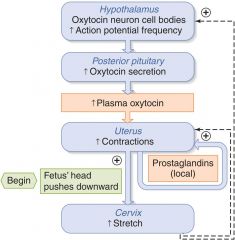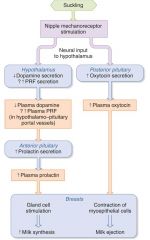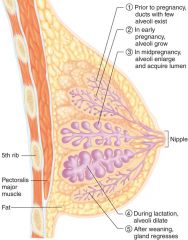![]()
![]()
![]()
Use LEFT and RIGHT arrow keys to navigate between flashcards;
Use UP and DOWN arrow keys to flip the card;
H to show hint;
A reads text to speech;
9 Cards in this Set
- Front
- Back
- 3rd side (hint)
|
Capacitation
|
after several hours in the female reproductive tract the sperm are able to fertilize the egg; final maturation due to:
i.Whip-like motion of the tail ii.Secretions from the female reproductive tract cause changes to the sperm cytoplasm allowing for fertilization Fertilization:24-48 hours after ovulation in the fallopian tube |
|
|

Fertilization
|
1.Sperm moves through granulosa cells and binds to glycoprotein receptors for sperm head proteins in the zone pellucida
2.Receptor binding triggers acrosome reaction – enzymes digest a pathway for the sperm 3.Fusion of egg and sperm plasma membranes 4.Polyspermy – blocked by cortical reaction: enzymes which cause inactivation of sperm binding sites 5.Egg completes second meiotic division 6.Egg and sperm nuclei fuse and egg enzymes required for early mitotic divisions are activated |
|
|

Implantation
|
Fertilized egg remains in fallopian tube 3-5 days and undergoes cleavage (mitotic divisions), progesterone relaxes tube slowing muscluar movements
2.Blastocyst stage – cells begin to differentiate, hollow layer (trophoblast) with inner cells mass (embryo) 3.Progesterone levels are rising (days 14-21 of menstrual cycle) enriching the uterine wall 4.Implantation of trophoblast into uterine wall (becomes part of the placenta) 5.Proteolytic enzymes allow blastocyst to imbed deep in endometrial layer |
|
|
|
Hormonal Control Placental Endocrinology
|
1.Human chorionic gonadotropin (hCG)
•Secreted by blastocyst and placenta •Growth of corpus luteum – keep hormones coming! 2.Estrogens •Secrete by corpus luteum •Stimulates growth of uterine wall and mammary ducts •Suppresses FSH and LH release 3.Progesterone •Secreted by the placenta and corpus luteum •Suppresses uterine contractions •Growth of decidual cells (nutrition for placenta) •Suppresses LH and FSH release |
|
|
|
Other hormones elevated:
|
Aldosterone
ii.Cortisol iii.Human chorionic sommamammatropin (hCS) – similar to growth hormone, also known as Human Placental Lactogen iv.Parathyroid hormone v.Thyroid hormone vi.Relaxin – promotes development of placenta |
|
|
|
Hormonal Control - Timing of hormones over pregnancy
|
Pregnancy
Physiological Changes: Digestive: morning sickness, reduced GI motility leads to (constipation) and heartburn, greater nutritional and vitamin demand Circulation: increased blood volume due to water retention and blood cell production, increase cardiac output Respiration: increased tidal volume and hyperventilation due to increased progesterone Renal: rising aldosterone and progesterone lead to salt and water retention, compression of bladder |
|
|
|
Hormonal Control - 2
|
Preeclampsia and eclampsia (with seizures): toxemia of Pregnancy
• Hypertension due to excess fluid and edema associated with urine excretion of proteins • Can cause placental insufficiency and fetal distress • Treatments: anti-hypertensives and anticonvulsive mediations Gestational Diabetes: hormonal changes alter cells responsiveness to insulin • Rise in blood sugar may hinder growth and development of fetus (larger baby) • Treatments: diet, exercise, monitoring, insulin injections, glyburide (inhibits pancreatic ion channels increasing the release of insulin) |
|
|

Parturition (Birth)
|
During 7th month – fetus turns into a head down position
Contractions reduce maternal blood flow to the placenta – ischemia causes pain Autonomic nervous system has little role Signals for contractions – positive feedback loops 1.Stretch of uterus increases firing of smooth muscles 2.Prostaglandins secreted by uterus stimulate smooth muscle 3.Neural inputs to hypothalamus stimulate release of oxytocin (estrogen rise late in gestation increase oxytocin receptor expression) |
|
|

Lactation
|
Lactation – secretion of milk by the breasts
Anatomy: functional unit is the mammary gland (develops during pregnancy) • Alveoli connected to ducts – estrogen stimulates growth • Myoepithelial cells – surround alveoli Milk synthesis promoted by prolactin (dopamine inhibits in non-pregnant women) • Prolactin secretion rises during pregnancy • Estrogen and progesterone inhibit prolactin actions on mammary glands (No Lactation during pregnancy) • Following birth prolactin effective in stimulating milk production • Requires: insulin, cortisol, PTH and growth hormone • Prolactin levels stimulated by nursing Milk letdown: Oxytocin stimulates myoepithelial cells |

|

